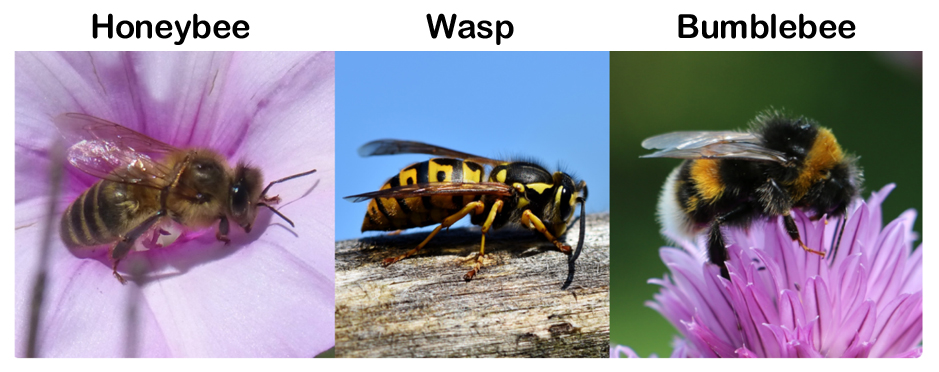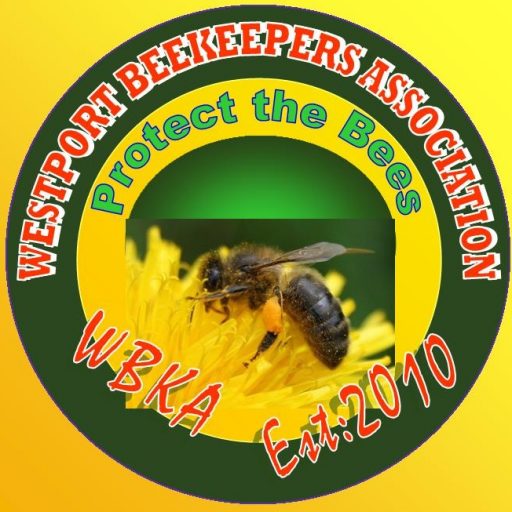…The flowers are blooming, and the pollinators are hard at work. In addition, starting around mid-May honeybees may be swarming. This is quite natural.
Some view a bee colony as akin to a collective organism. This ‘organism’ collects nectar and pollen to feed on, to rear its young bees, and to store away for the next winter. It also needs to reproduce.
Honeybee colonies reproduce by swarming. They have been doing this for millennia and without human intervention. An older queen may leave a hive along with most of the workers, if it is felt there is not enough room, or if the bees no longer like where they are. This swarm may already have located a new home, or the bees may settle on a bush, in a tree, or on a wall in a cluster while the scouts find a suitable home. They will have left behind some workers, larvae, and eggs. These workers may then raise a new queen and start afresh.
Another scenario is that a young queen is reared, flies off with just a few thousand workers, mates , and then settles down waiting for a new home to be found by her scouts. Again, this is a cluster of many bees surrounding their queen, albeit a much smaller one.
Beekeepers do, by and large, try to manage their bee colonies in such a way as to dissuade them from swarming. Beekeepers want as many bees in their hives as possible to maximise honey production. Swarming depletes the original colony, which in turn reduces its honey production. Housed bees can and will swarm, even with the best intervention by the beekeeper. There are also wild bee colonies living in hollowed trees in the woods and other places. These will do what bees do naturally – swarm.
So, what is it that I have here?
All that buzzes is not necessarily a honeybee. As I wrote recently, there are many species of bees, and then there are wasps. All are important members of our environment and of its biodiversity.
Of most relevance here are the honeybee, the wasp, and the bumblebee.

Bumblebees tend to be quite fuzzy and can range in size from 1cm to around 3cm. There are many bumblebee species. Many have bands of different colours. Many are solitary bees, nesting in stone walls or in the ground. There are a few that will form larger colonies. They can nest in any hollow space, including in a wall. Bumblebees are important pollinator species, often working on flowers that honeybees cannot. They perform buzz pollination which honeybees cannot do. They are important pollinators of some commercial crops, including apples and tomatoes. The pollen adheres to the bumblebee’s hairs and is transported from one flower to the next.
Wasps will have some short hairs on their middle section (thorax), but their abdomen is hairless and often shiny. The most common are yellowjackets, with distinctive yellow and black bands. Wasps often build nests out of a paper-like material. They can also live in the ground, in cavities in a wall, or any hollow space.
Honeybees are fuzzy, but not nearly as thickly as bumblebees. They are much slenderer and are smaller. The hairs on their hind legs help them collect pollen, which is an important food source for them. Pollen also adheres to their body hair and is transported from one flower to the next. Our native honeybee is quite black. The imported bees are orange/yellow with some darker banding. Hybrid bees have varying amounts of yellow and black banding on their abdomen.
Every year there are numerous honeybee swarms sighted and often successfully collected and rehomed by local beekeepers. If you see a honeybee swarm or cluster, it is best to leave them alone and cordon off the area if possible. They are important pollinators and warrant the effort of giving them a new home.
To report a honeybee swarm, contact your nearest beekeeper’s association:
- Ballina Beekeeper’s Association: Judewalsh30@gmail.com, https://www.facebook.com/ballinabeekeepers.mayo/
- Westport Beekeepers Association: www.wbkc.info, SecretaryWBKA@gmail.com
- Erris Beekeepers Association: https://www.facebook.com/errisbeekeepers/
- Ballyhaunis Beekeepers Association: ballyhaunisbees@gmail.com, https://www.facebook.com/ballyhaunisbeekeepers/
- Connemara Beekeepers Association: ConnemaraBeekeepers.ie, secretary.connemarabeekeepers@gmail.com
Anywhere in Ireland: Swarms.ie or https://irishbeekeeping.ie/about-us/find-a-beekeepers-association-near-you/ Information that will be needed about a swarming incident:
- Please provide the nearest town and Eircode of the location of the swarm.
- If you can, take a picture and send this in. This will help confirm that it is indeed a honeybee swarm.
- Please provide your mobile phone number at which you can be contacted by a beekeeper. The beekeeper’s association will put out a message to its members to alert them to the swarm. A beekeeper in the vicinity may volunteer to come collect the swarm and will contact you first.
- If someone has committed to help with a swarm, please get back to whoever you contacted first as sometimes more than one beekeeper will arrive at the location and may have travelled many miles incurring costs to do so.
Please bear in mind that if the bees have moved into a house, chimney, or barn, there may be very little a local beekeeper can do. They are, by and large, not insured or licensed to deconstruct or work at heights. They may also not be able to help with wasp or bumblebee nests.
Alex: SecretaryWBKA@gmail.com
